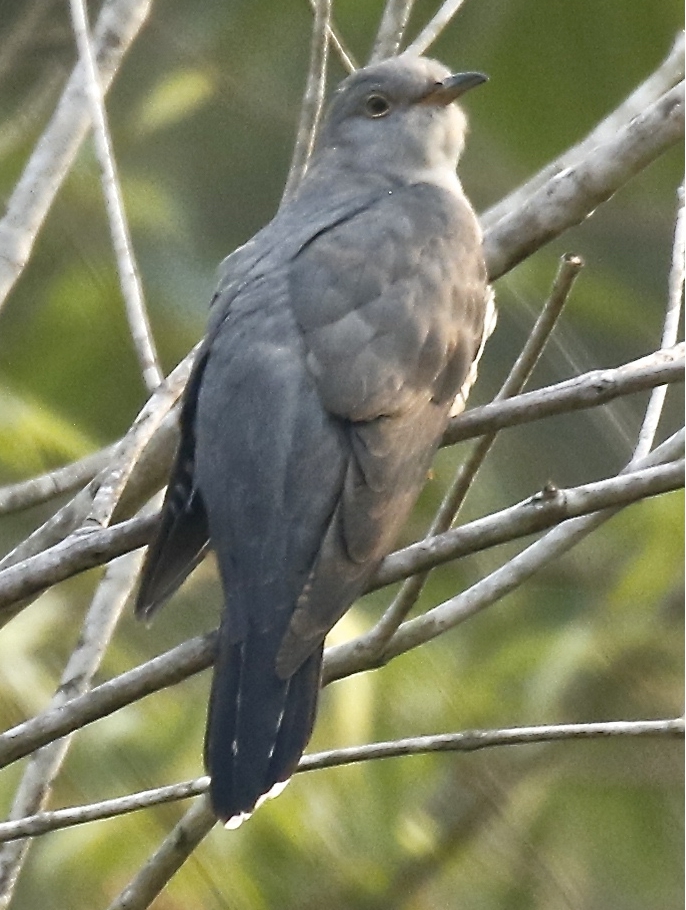|
Himalayan Cuckoo
The Himalayan cuckoo (''Cuculus saturatus'') is a species of cuckoo in the genus ''Cuculus''. It breeds from the Himalayas eastward to southern China and Taiwan. It migrates to southeast Asia and the Greater Sunda Islands for the winter. It was formerly known as "Oriental cuckoo" and contained several subspecies found over most of Asia. In 2005, it was determined that this "species" consists of three distinct lineages: * Himalayan cuckoo, ''Cuculus (saturatus) saturatus'' * Oriental cuckoo proper, ''Cuculus (saturatus) optatus'' * Sunda cuckoo, ''Cuculus (saturatus) lepidus'' These are usually seen as distinct species nowadays. As the type specimen of the former "Oriental" cuckoo is a bird of the Himalayan population, the name ''saturatus'' applies to the Himalayan cuckoo if it is considered a species. References Himalayan cuckoo Birds of the Himalayas Birds of South China Himalayan cuckoo Himalayan cuckoo The Himalayan cuckoo (''Cuculus saturatus'') is a species of cuck ... [...More Info...] [...Related Items...] OR: [Wikipedia] [Google] [Baidu] |
East Sikkim
Gangtok District, formerly the East Sikkim district, is an administrative district of the Indian States and territories of India, state of Sikkim. It was renamed in 2021 as a result of administrative reorganisation of the state, which also saw three subdivisions of the East Sikkim district spawned off as a separate Pakyong district. The headquarters of the Gangtok district is Gangtok, which is also the state capital. Gangtok is the hub of all administrative activity in the state. The district is bounded by the Pakyong district in the south and southeast, Bhutan in the east, the People's Republic of China in the northeast, North Sikkim district, Mangan District in the north and South Sikkim district, Namchi District in the west. The civilian region is administered by a district collector, appointed by the state government. A major general is assigned to administer military forces in the district. As of 2011 it is the most populous of the six districts of Sikkim. History East Si ... [...More Info...] [...Related Items...] OR: [Wikipedia] [Google] [Baidu] |
Greater Sunda Islands
The Greater Sunda Islands (Indonesian and Malay: ''Kepulauan Sunda Besar'') are four tropical islands situated within Indonesian Archipelago, in the Pacific Ocean. The islands, Borneo, Java, Sulawesi and Sumatra, are internationally recognised for their ecological diversity and rich culture. Together with the Lesser Sunda Islands to their southeast, they comprise the archipelago known as the Sunda Islands. Mainly part of Indonesia, each island is diverse in its ethnicity, culture and biological attributes. The islands have a long and rich history which has shaped their cultural backgrounds. Sumatra Geography Sumatra is the second largest, most westerly oriented Indonesian island, and the sixth largest island globally. Spanning , Sumatra is home to human civilisations and tropical rainforests, which harbour a huge range of wildlife. Its close proximity to the Equator (1º S, 101º E) dictates its tropical climate, so that it is subject to the forces of climatic events El Niño ... [...More Info...] [...Related Items...] OR: [Wikipedia] [Google] [Baidu] |
Birds Of South China
Birds are a group of warm-blooded vertebrates constituting the class Aves (), characterised by feathers, toothless beaked jaws, the laying of hard-shelled eggs, a high metabolic rate, a four-chambered heart, and a strong yet lightweight skeleton. Birds live worldwide and range in size from the bee hummingbird to the ostrich. There are about ten thousand living species, more than half of which are passerine, or "perching" birds. Birds have whose development varies according to species; the only known groups without wings are the extinct moa and elephant birds. Wings, which are modified forelimbs, gave birds the ability to fly, although further evolution has led to the loss of flight in some birds, including ratites, penguins, and diverse endemic island species. The digestive and respiratory systems of birds are also uniquely adapted for flight. Some bird species of aquatic environments, particularly seabirds and some waterbirds, have further evolved for swimming. Birds ... [...More Info...] [...Related Items...] OR: [Wikipedia] [Google] [Baidu] |
Birds Of The Himalayas
The ecology of the Himalayas varies with climate, rainfall, altitude, and soils. The climate ranges from tropical at the base of the mountains to permanent ice and snow at the highest elevations. The amount of yearly rainfall increases from west to east along the southern front of the range. This diversity of climate, altitude, rainfall and soil conditions supports a variety of distinct plant and animal species, such as the Nepal gray langur (''Semnopithecus schistaceus'') Lowland forests On the Indo-Gangetic plain at the base of the mountains, an alluvial plain drained by the Indus and Ganges-Brahmaputra river systems, vegetation varies from west to east with rainfall. The deserts and xeric shrublands, xeric Northwestern thorn scrub forests occupy the plains of Punjab, Pakistan, Pakistani and the Punjab, India, Indian Punjab. Further east lie the Upper Gangetic Plains moist deciduous forests of Uttarakhand and Uttar Pradesh and the Lower Gangetic Plains moist deciduous forests of Bi ... [...More Info...] [...Related Items...] OR: [Wikipedia] [Google] [Baidu] |
Type Specimen
In biology, a type is a particular wiktionary:en:specimen, specimen (or in some cases a group of specimens) of an organism to which the scientific name of that organism is formally attached. In other words, a type is an example that serves to anchor or centralizes the defining features of that particular taxon. In older usage (pre-1900 in botany), a type was a taxon rather than a specimen. A taxon is a scientifically named grouping of organisms with other like organisms, a set (mathematics), set that includes some organisms and excludes others, based on a detailed published description (for example a species description) and on the provision of type material, which is usually available to scientists for examination in a major museum research collection, or similar institution. Type specimen According to a precise set of rules laid down in the International Code of Zoological Nomenclature (ICZN) and the International Code of Nomenclature for algae, fungi, and plants (ICN), the ... [...More Info...] [...Related Items...] OR: [Wikipedia] [Google] [Baidu] |
Horsfield's Cuckoo
The Oriental cuckoo or Horsfields cuckoo (''Cuculus optatus'') is a bird belonging to the genus ''Cuculus'' in the cuckoo family Cuculidae. It was formerly classified as a subspecies of the Himalayan cuckoo (''C. saturatus''), with the name 'Oriental cuckoo' used for the combined species. Differences in voice and size suggest that it should be treated as a separate species.King, Ben (2005The taxonomic status of the three subspecies of ''Cuculus saturatus''. ''Bulletin of the British Ornithologists' Club'', 125 (1):48-55 The binomial name ''Cuculus horsfieldi'' has often been used instead of ''Cuculus optatus'', but is now usually considered to be a junior synonym.Peterson, Alan P. (ed.) (1999) Zoological Nomenclature Resource (Zoonomen).' Accessed 22/08/07. Description It is 30-32 centimetres long with a wingspan of 51-57 centimetres and a weight of 73-156 grams. The adult male has a grey head, breast and upperparts. The belly is creamy-white with dark bars. The vent is frequently ... [...More Info...] [...Related Items...] OR: [Wikipedia] [Google] [Baidu] |
Subspecies
In biological classification, subspecies is a rank below species, used for populations that live in different areas and vary in size, shape, or other physical characteristics (morphology), but that can successfully interbreed. Not all species have subspecies, but for those that do there must be at least two. Subspecies is abbreviated subsp. or ssp. and the singular and plural forms are the same ("the subspecies is" or "the subspecies are"). In zoology, under the International Code of Zoological Nomenclature, the subspecies is the only taxonomic rank below that of species that can receive a name. In botany and mycology, under the International Code of Nomenclature for algae, fungi, and plants, other infraspecific ranks, such as variety, may be named. In bacteriology and virology, under standard bacterial nomenclature and virus nomenclature, there are recommendations but not strict requirements for recognizing other important infraspecific ranks. A taxonomist decides whether ... [...More Info...] [...Related Items...] OR: [Wikipedia] [Google] [Baidu] |
Taiwan
Taiwan, officially the Republic of China (ROC), is a country in East Asia, at the junction of the East and South China Seas in the northwestern Pacific Ocean, with the People's Republic of China (PRC) to the northwest, Japan to the northeast, and the Philippines to the south. The territories controlled by the ROC consist of 168 islands, with a combined area of . The main island of Taiwan, also known as ''Formosa'', has an area of , with mountain ranges dominating the eastern two-thirds and plains in the western third, where its highly urbanised population is concentrated. The capital, Taipei, forms along with New Taipei City and Keelung the largest metropolitan area of Taiwan. Other major cities include Taoyuan, Taichung, Tainan, and Kaohsiung. With around 23.9 million inhabitants, Taiwan is among the most densely populated countries in the world. Taiwan has been settled for at least 25,000 years. Ancestors of Taiwanese indigenous peoples settled the isla ... [...More Info...] [...Related Items...] OR: [Wikipedia] [Google] [Baidu] |
India
India, officially the Republic of India (Hindi: ), is a country in South Asia. It is the seventh-largest country by area, the second-most populous country, and the most populous democracy in the world. Bounded by the Indian Ocean on the south, the Arabian Sea on the southwest, and the Bay of Bengal on the southeast, it shares land borders with Pakistan to the west; China, Nepal, and Bhutan to the north; and Bangladesh and Myanmar to the east. In the Indian Ocean, India is in the vicinity of Sri Lanka and the Maldives; its Andaman and Nicobar Islands share a maritime border with Thailand, Myanmar, and Indonesia. Modern humans arrived on the Indian subcontinent from Africa no later than 55,000 years ago., "Y-Chromosome and Mt-DNA data support the colonization of South Asia by modern humans originating in Africa. ... Coalescence dates for most non-European populations average to between 73–55 ka.", "Modern human beings—''Homo sapiens''—originated in Africa. Then, int ... [...More Info...] [...Related Items...] OR: [Wikipedia] [Google] [Baidu] |
China
China, officially the People's Republic of China (PRC), is a country in East Asia. It is the world's most populous country, with a population exceeding 1.4 billion, slightly ahead of India. China spans the equivalent of five time zones and borders fourteen countries by land, the most of any country in the world, tied with Russia. Covering an area of approximately , it is the world's third largest country by total land area. The country consists of 22 provinces, five autonomous regions, four municipalities, and two Special Administrative Regions (Hong Kong and Macau). The national capital is Beijing, and the most populous city and financial center is Shanghai. Modern Chinese trace their origins to a cradle of civilization in the fertile basin of the Yellow River in the North China Plain. The semi-legendary Xia dynasty in the 21st century BCE and the well-attested Shang and Zhou dynasties developed a bureaucratic political system to serve hereditary monarchies, or dyna ... [...More Info...] [...Related Items...] OR: [Wikipedia] [Google] [Baidu] |


.jpg)

.jpg)
